Flash Photography
X-series Auto Electro-flashes
(Accessory)
There are some dedicated Minolta electronic flash units that worked fine with the
XD-7. To make taking flash pictures as simple and easy as it is to take normal shots
with your XD-7. Minolta offers four automatic electronic flashes designed especially
for your camera.
All of the four X-series Auto Electro-flashes
feature dedicated-flash functions that electronically set the camera for proper X-sync
(1/100 sec.), and activate a blinking flash-ready signal in the viewfinder when the
flash is charged and ready to fire.
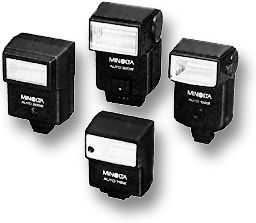 |
This and other individual features make the Auto Electro-flash lineup one of the earlier model that has the most comprehensive offered by any camera manufacturer. Thyristor circuitry for winder synchronization and maximum battery life (200X and 320X) bounce flash (132X and 320X), filters for special effects (132X and 320X), multiple auto-aperture settings and manual mode (all models), and Ni-Cd battery power supply (all models) are just a few of the feature available to you in the X-series line. |
From the compact and economical
118X to the 320X with its complete accessory flash system and exclusive Variable
Guide-Number/ Power Control, there is an X-series flash to meet any imaginable need.
Do you actually has to use an original Minolta flash with the XD-7 ? Not necessary
if you think the flash ready light in the viewfinder is not a prime factor. this
is especially true if you have purchased your XD-7 as used in the secondary market.
Well, most newer flash units made by Minolta is still offering such ready light feature
and doesn't restrictive to the few units mentioned above. However, since the XD-7
has no TTL flash exposure metering as with the X-700, third party flash units like
Sunpak or Vivitar can be of a good entry point for flash photography. It still be
used in AUTO or MANUAL mode. For flash units other than X series Auto Electro-flashes
Synchronization
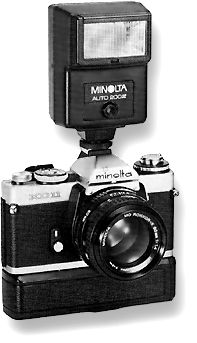 |
|
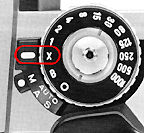 |
Note: As indicated by the table, 1/100 is the maximum shutter speed for proper X synchronization. Slower speeds can also be used under certain conditions if desired for particular effects. Be sure not to use speeds faster than 1/100, (i.e. 1/125 and upward) with electronic or auto-flash units. |
Connecting flash units
 |
 |
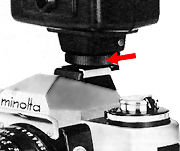 |
Cordless clip-on flash units are attached and electrically connected by simply sliding them into the camera's hot shoe. Sync. cords of either clip-on or bracket-type conventional units requiring them must be plugged into the camera's sync terminal for operation. Bracket-type flash units are attached to the camera by means of its tripod socket. |
DATA BACK D (Accessory)
This convenient accessory imprints the date or other useful data on the film as the exposure is made to help identify or classify your pictures. It attaches in place of your XD-7's removable regular back cover and synchronizes with the shutter by means of a cord which is inserted into the camera's sync. terminal.
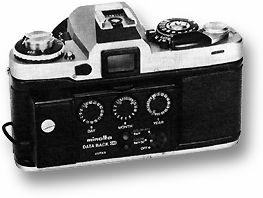 |
Three large dials set numbered day, month and year indications which appear in reverse order on the bottom right corner of the picture. The ability to set letters and blank spaces further increases the data back's usefulness for scientific and other purposes. |
A red LED which also operates as a battery check, lights to signal when data is imprinting. Data exposure intensity can be adjusted for either normal or high-speed black and white or color film. Power is provided by two tiny alkaline-manganese or silver-oxide cells.
AUTO Winder D (Accessory)
The Auto Winder D is an automatic film winder that helps the photographer focus his full attention on the creative aspects of photography by removing the interruption of having to wind the film after each exposure. Attaching is quick and easy with no access caps to remove or store. Just a light touch of the shutter release is all that is required to take either successive or single frames with the winder automatically advancing the film after each one.
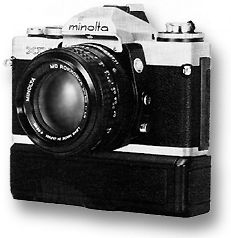 |
The winder drive mechanism stops automatically at the end of each cartridge and film can be easily rewound with winder attached. Winder-assisted multiple exposures are easily accomplished with no special operations or techniques. |
All of these features combine with
the unique XD-7 to help you to capture the fast paced action of a sports car race
or the fleeting expressions of a child at play.
Using Optics other than MD lenses
Besides MD lenses, virtually all SLR lenses and accessories manufactured by Minolta
may be used on your XD-7 automatically, in aperture priority, or manual mode. To
use other than MD lenses on your XD-7 proceed as follows.
MC lenses
Minolta MC lenses should be used only in aperture priority (A) automatic or manual
(M) modes. When used in shutter-speed priority (S) automatic mode, only under- or
over-range indicators will light in the viewfinder and improper exposure will result.
Auto Rokkor
Because these lenses have no meter coupling lug, metering with Auto Rokkor's is by the stop-down method as follows:
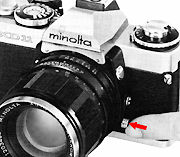 |
1. After focusing, push the stop-down button all the way in. |
3. Release the stop-down button when the exposure range or setting has been determined, and take the picture. (Because the XD-7 meters while the aperture is closing to obtain correct exposure settings for automatic modes, it is unnecessary to stop the lens down before releasing the shutter.
RF (mirror-type)
and manual preset lenses
Proceed as for Auto Rokkors above, except that the stop-down button need not be pushed,
as metering is done and exposure made without its use.
Caution: Be sure to use a proper lens for your
XD-7 camera. The Minolta lens which is proper for this camera is the MD lens. When
using MC and other types of lenses, the aperture priority mode and manual mode will
work, but the shutter priority mode will not work. Therefore, in order to fully use
the multimode operation of the XD-7 [aperture priority, shutter priority and manual)
use a proper lens.
Note:
ï Be sure to use only A mode (aperture priority) or M mode {manual) when making pictures
using close-up equipment or with the Minolta 2X converter as improper exposure may
result if S mode is used.
ï The Minolta 35mm f/2.8 Shift CA lens should be used in M mode {manual) only. For
proper exposure, metering must be done at the non-shift position.
Remote Cords S & L (Accessory)
These cords are designed for operating the XD-7 let all speeds except "B") from a distance. Each screws into the threaded socket provided in the operating button.
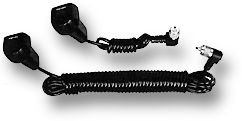 |
The Cord S is 50cm [about 20 in.) long, while the Cord L is 5m 116-1/2 ft.) These cords facilitate shots mounted on a tripod or remote wildlife pictures. In combination with the Auto Winder D, the Cord L can be used to make single or continuous sequence exposures at the subject position, from a remote location, etc. |
| Previous | Next | Specifications
or Skip this part to care and maintenance section
| Back | to Main Index Page of Minolta XD-7
| Minolta XK/XM/X1 | Minolta X-700 | Minolta Maxxum 7000 |
| Message Board | for your favourite Minolta XD-7/XD-11 SLR camera(s)
| Message Board | for your Minolta Optics in a shared environment
| Message Board | Specifically tor Dispose or Looking for Minolta Photographic equipment
Home - Photography in Malaysia |
Copyright © 2000 leofoo® MIR Web Development Team
Credit: Satosh Oka for some of the very high quality images for the Minolta CD-7 and XK Motor used in this site. Oleg Volk, who has offered some help during the initial stage of development of this site; Stephen Schwartz on the few new images of XK; Mark Wasmer for the original Brouche of the few Minolta cameras; Dick Sullivan whom I used some of his info as reference in this site; Mr Poon who has helped me eith some of the images used in this site. Minolta, XD-7, XK, XM, X1, Rokkor, MC lenses are either registered tradenames or trade mark of Milnolta Optical Co. Ltd, Japan. Asite dedicted to all Minolta fans worldwide.